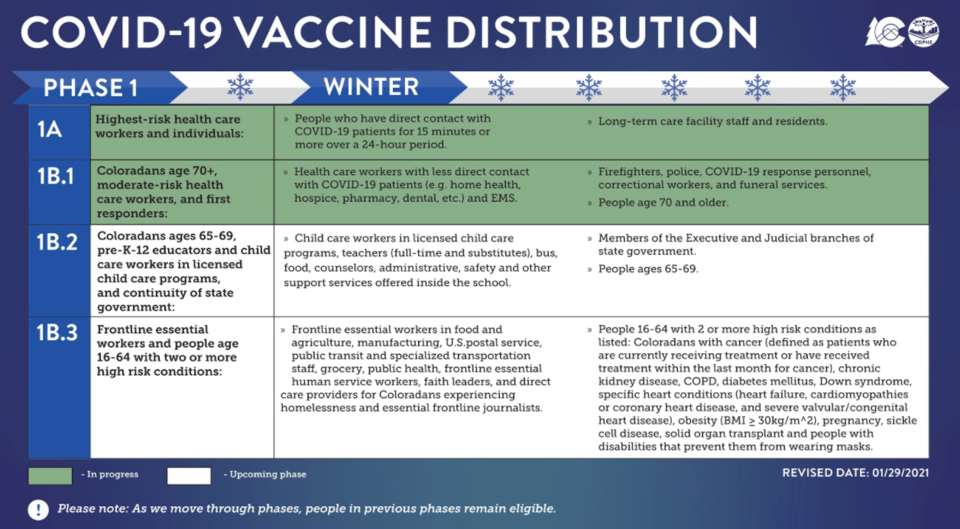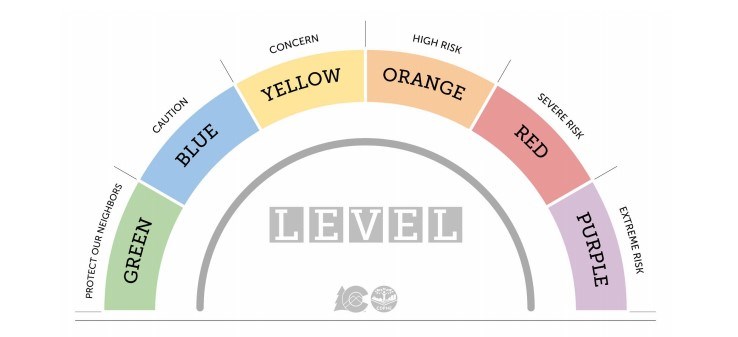Boulder County supports most of the proposed COVID-19 dial dashboard changes suggested by Gov. Jared Polis, however, there remain some areas of concern.
Polis in a call on Saturday introduced the proposed changes to mayors, city managers, county commissioners and local public health agencies, seeking feedback.
The dial currently features six color-coded levels based on the rate of new COVID infections, test positivity rate, and the rate of new hospitalizations in a given county. Boulder County is currently at orange on the dial, two steps down from the most restrictive purple “Extreme Risk” level, and three steps up from the least-restrictive green “Protect Our Neighbors” status.
The proposed changes to the dial include:
• Raising the case rate threshold that would force a county to implement mitigation measures, such as curfews, or move to a more restrictive level dial. The change would mean many counties could move to less restrictive levels.
For example, the incidence rate for the level yellow — a step down from orange — would change from 100 to 175 new cases per 100,000 people over two weeks, to 100 to 300 new cases per 100,000 people over one week.
Boulder County as of Monday reported 282.4 new cases over the past 14 days, according to Boulder County Public Health data.
A move to yellow would allow restaurants, gyms and fitness centers, personal services businesses, offices, indoor and outdoor event venues and non-critical manufacturers to operate at 50% capacity instead of the 25% cap imposed at the orange level.
• Measuring the rate of new cases every week, instead of every two weeks, so the state can “more quickly respond to local conditions.”
• Requiring a lower test positivity rate for the yellow and orange levels, which means some counties might have to increase testing before they can qualify for a less-restrictive level.
Boulder County as of Monday had a 14-day positivity rate of 3.5%, which places it the least-restrictive green level on the current dial.
• Adding special consideration for counties with fewer than 20,000 people, since just a few new cases could increase their incidence rate enough to change their status on the dial.
Jeff Zayach, executive director of Boulder County Public Health, in the weekly COVID Community Update, said the county supports most of the proposed changes.
However, he said he is concerned about how the changes could impact the way local school districts operate, as well as populations most at risk for the virus.
He also said the county is seeking clarification on how hospital metrics, such as sufficient staffing, number of transfers and whether COVID cases exceed capacity.
Zayach said he does believe the change from a 14-day incidence period to a seven-day period will be a positive for the county.
“What it effectively does in Boulder County is brings down our numbers to about half of what they are,” he said. “It will more quickly move us down the dial.”
Polis, in an interview with Colorado Newsline, said “I’m hopeful that … the new dial system really takes into account a lot of the actual data from the last few weeks and months. We hope that this hits a little closer to the mark, and we’ll look forward to continuing to work to keep Coloradans safe while keeping our economy open.”
Zayach said residents can “expect more changes (to the dial) in the months in front of us,” as more vaccines are distributed.
While Boulder County has increased its number of vaccine providers to 32 and its capacity to distribute as many as 20,000 to 22,000 vaccines each week, BCPH Emergency Manager Chris Campbell said the county still isn’t receiving that many vaccines each week.
The number of vaccines distributed to Boulder County varies greatly from week to week. Last week it received only 800 doses, versus this week when it received 7,000, Campbell said.
As of Monday, 21,505 Boulder County residents had received one dose of the vaccine and 7,097 people had received the full course, according to health department data.
The county is still in phase 1B of vaccine distribution, which includes moderate-risk health care workers and people 70 and older. Zayach in Wednesday’s briefing reported the county has vaccinated 16,242 of 30,000 — 52.2% — of residents 70 and older.
Boulder County on Monday will vaccinating individuals who fall into the newly created Phase 1B.2 subcategory, which includes people 65 and older, pre-K through 12 educators, child care workers, licensed day care providers and individuals responsible for the continuity of government.
The 1B.2 category includes an additional 18,000 people eligible for the vaccine, including 14,104 Longmont residents who are 65 and older.
The state’s vaccination priority plan was updated on Jan. 29 to include two subcategories of Phase 1B —1B.2 and 1B.3, the latter of which includes essential frontline workers and people ages 16 to 64 with two more more conditions that put them at higher risk for the virus.
 The state's new COVID vaccine priority plan shared by Gov. Jared Polis' office on Friday, Jan. 29, 2021. Courtesy photo
The state's new COVID vaccine priority plan shared by Gov. Jared Polis' office on Friday, Jan. 29, 2021. Courtesy photoThe county is working to match providers and educators to more quickly distribute vaccines. St. Vrain Valley School District will work with UCHealth, Boulder Valley School District will work with Boulder Community Health and private schools will work with King Soopers and Safeway, according to Campbell.
Early education providers will be connected with Good Samaritan Hospital and a number of pharmacy partners. All school districts have detailed information on how to connect educators with more information on receiving the vaccine, Campbell said.
Despite improvements made to roll out the vaccine, the county recognizes there have been barriers to various communities receiving their shots. Campbell said the county is still working through many logistical challenges to reach those individuals.
He hopes community clinics will be established in the next few weeks. Mobile clinics also are an option to reach these underserved communities. Campbell said it is likely mobile clinics will follow mobile testing sites that have already built trust.



